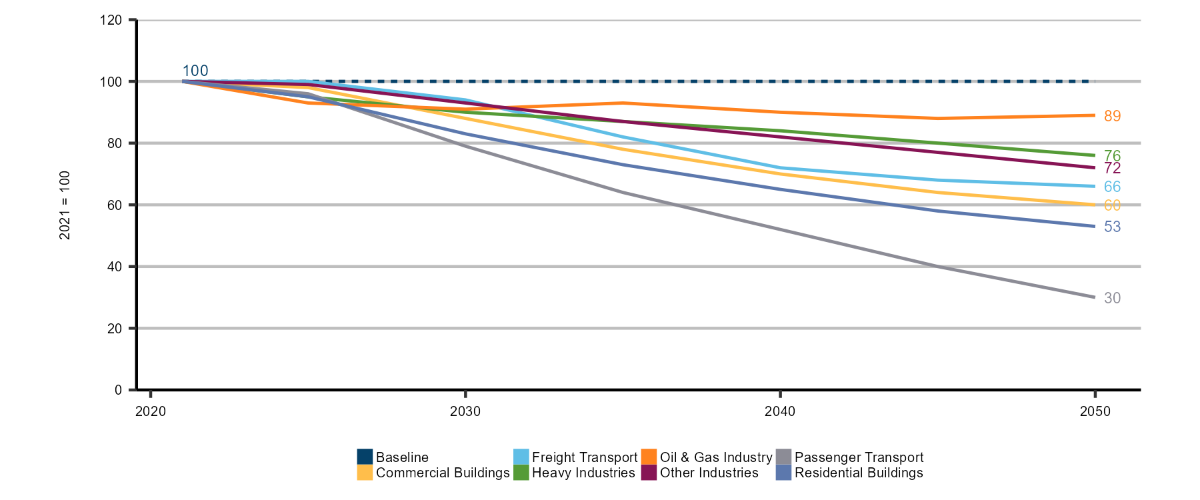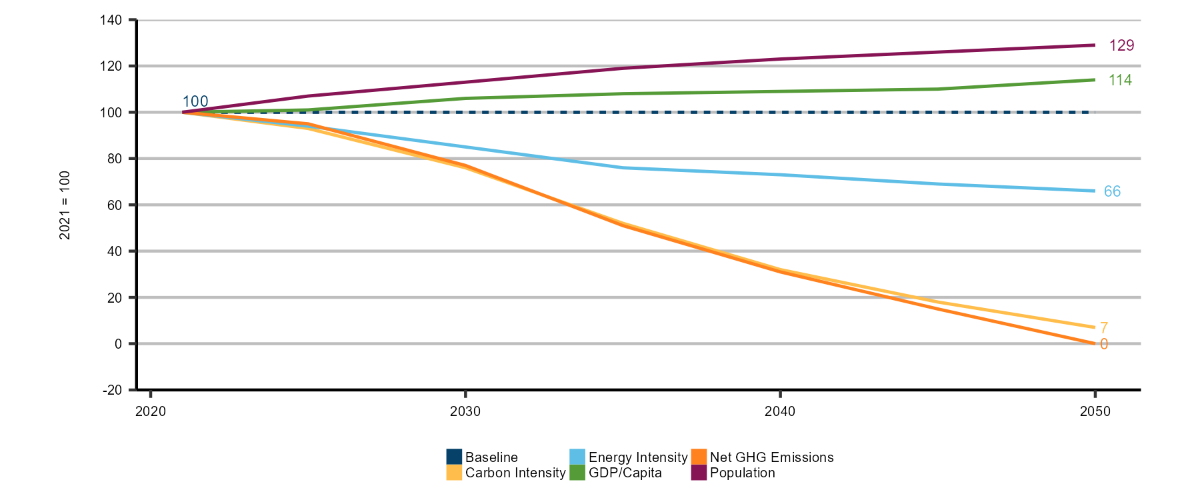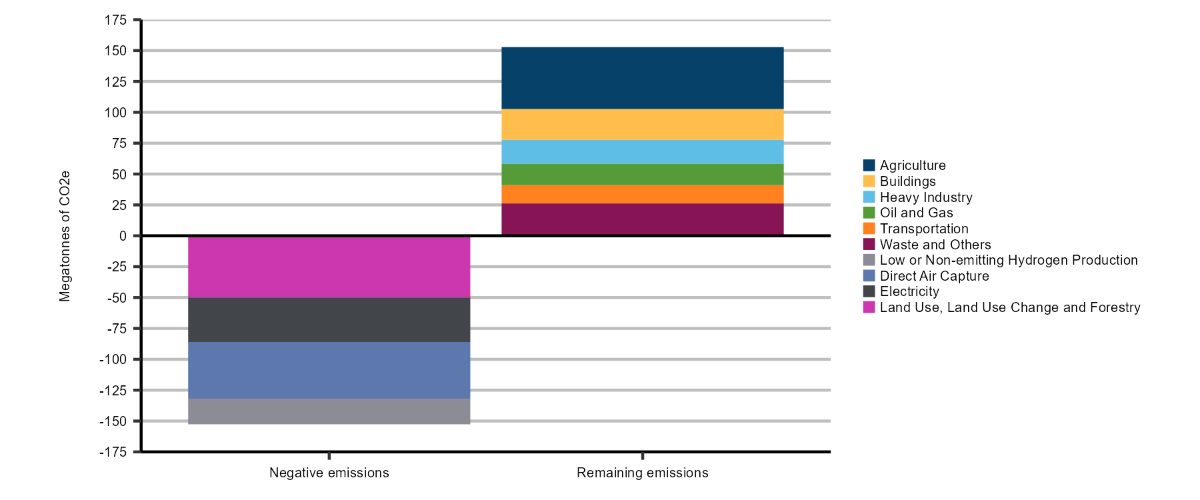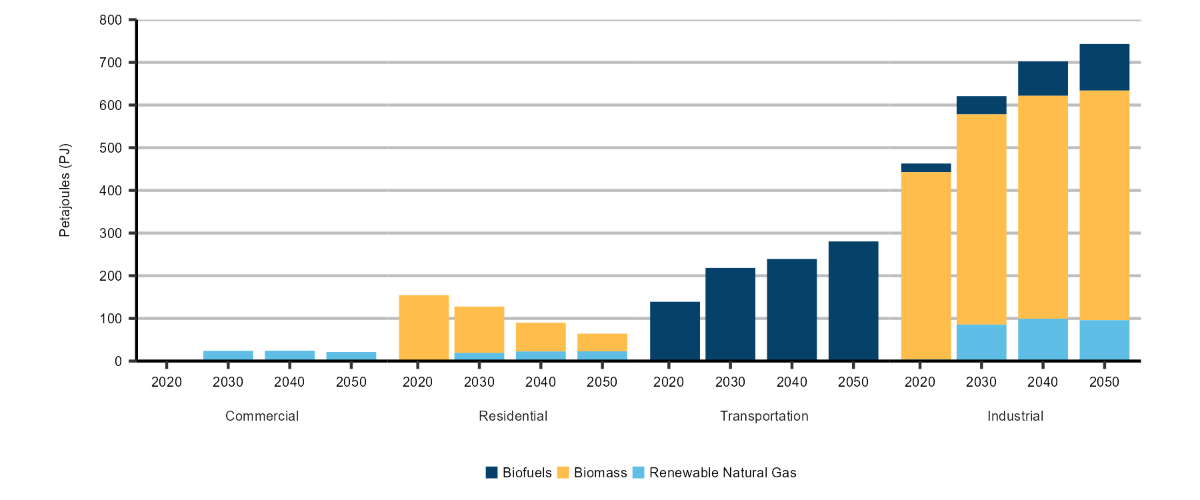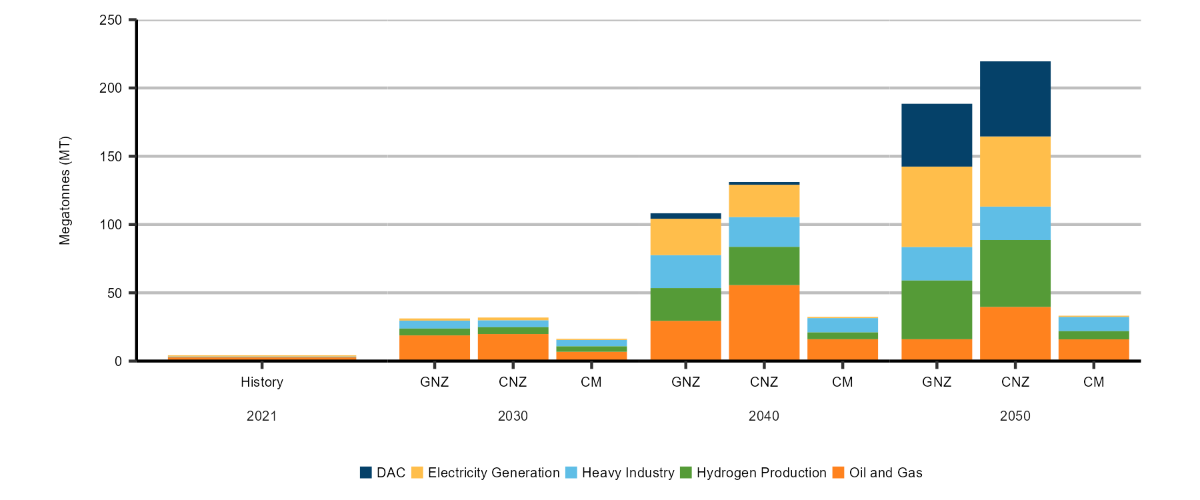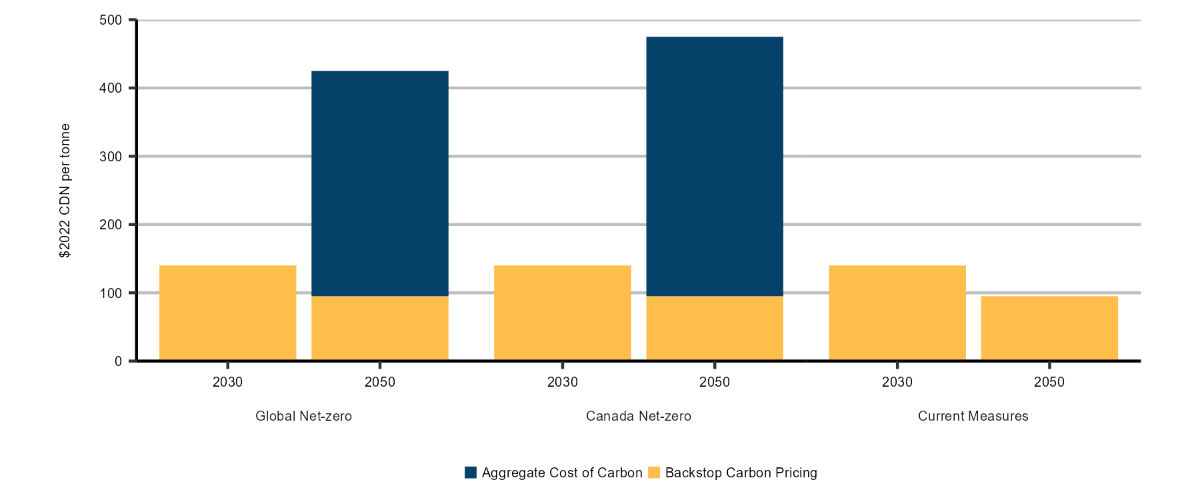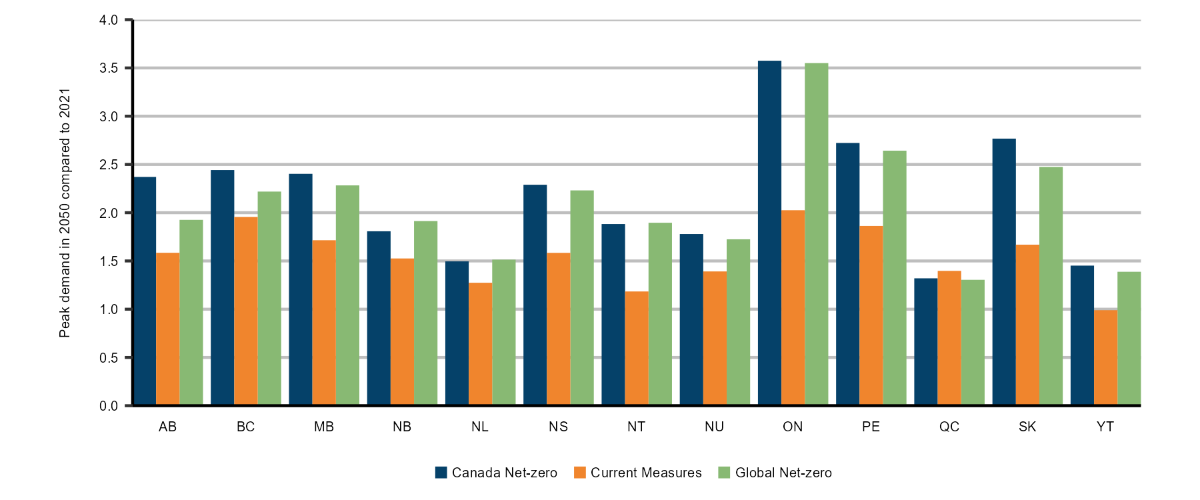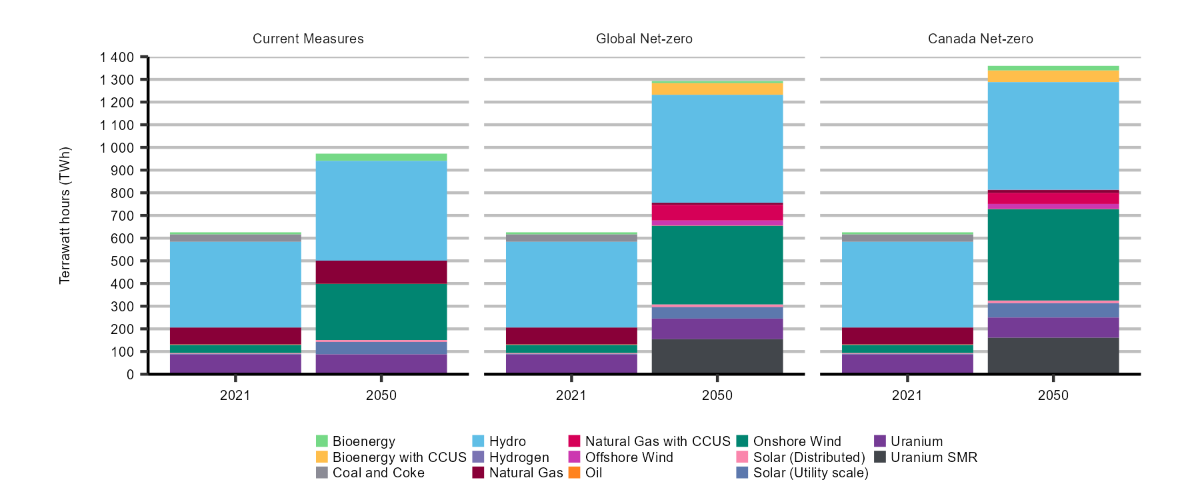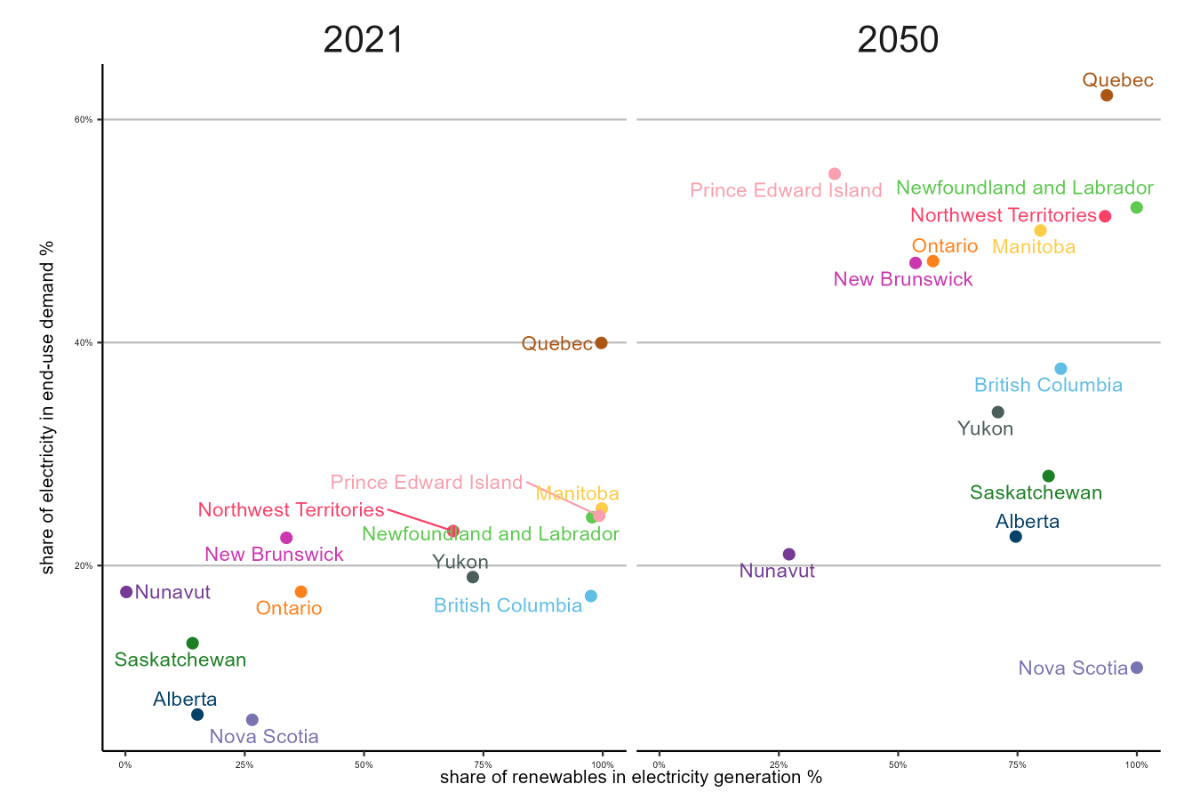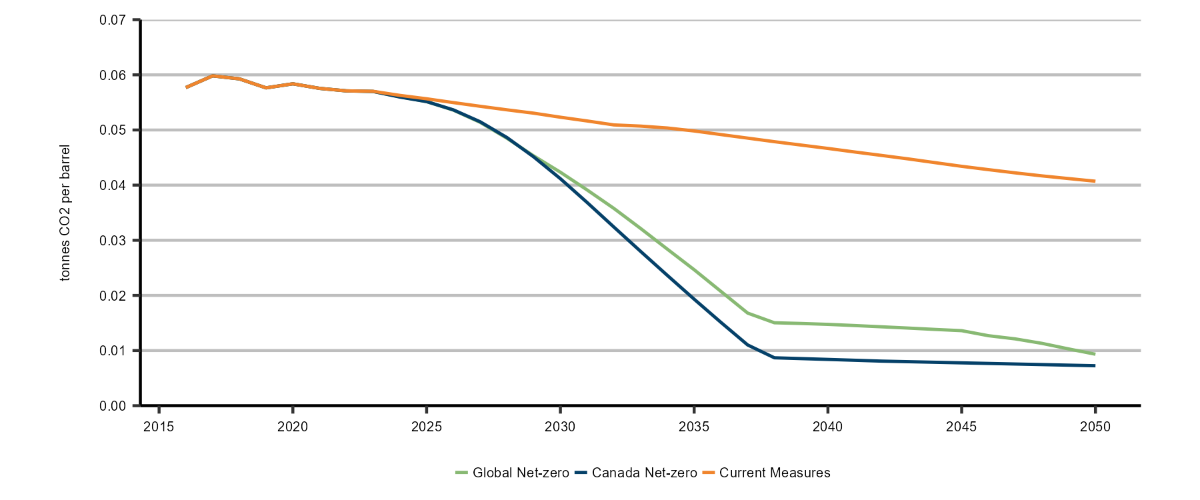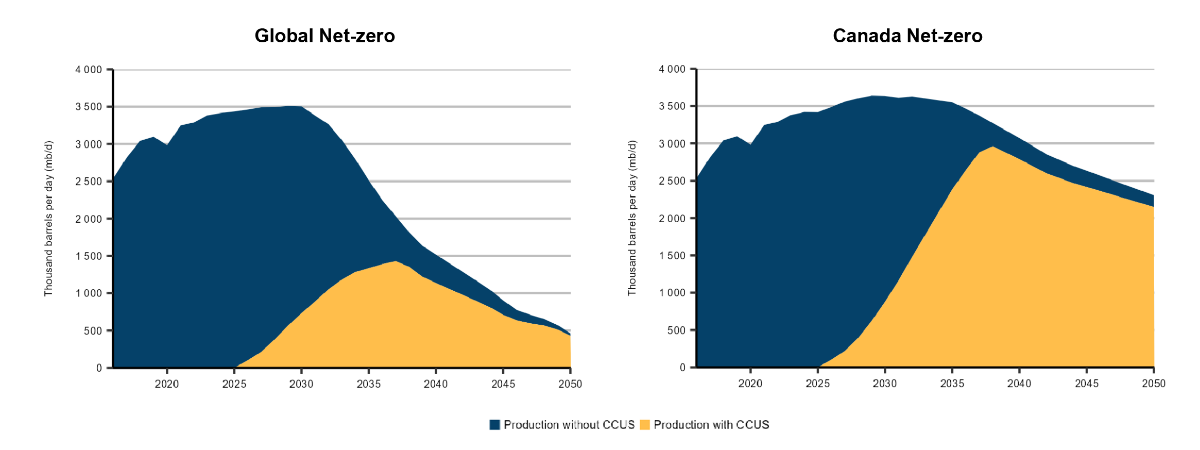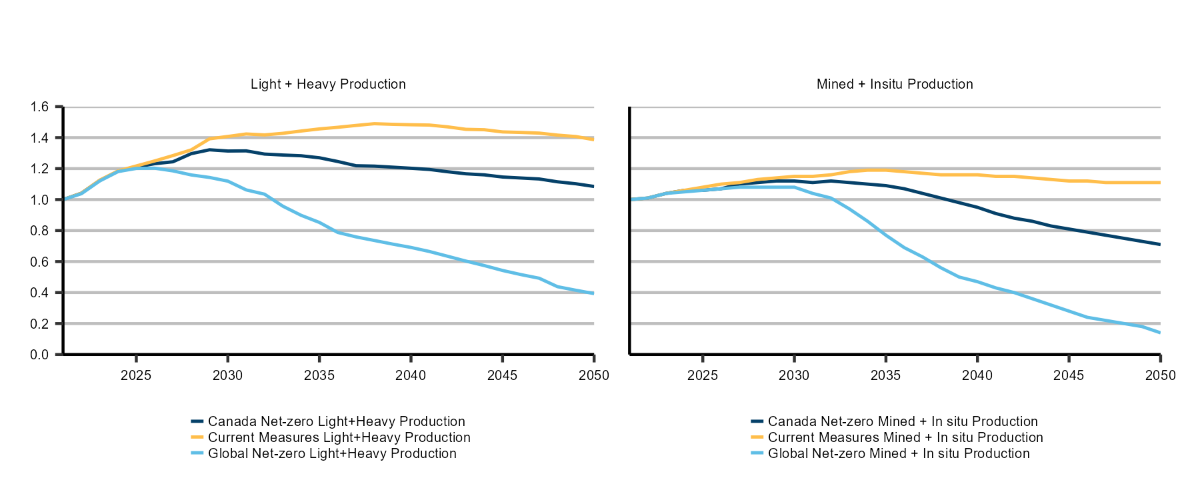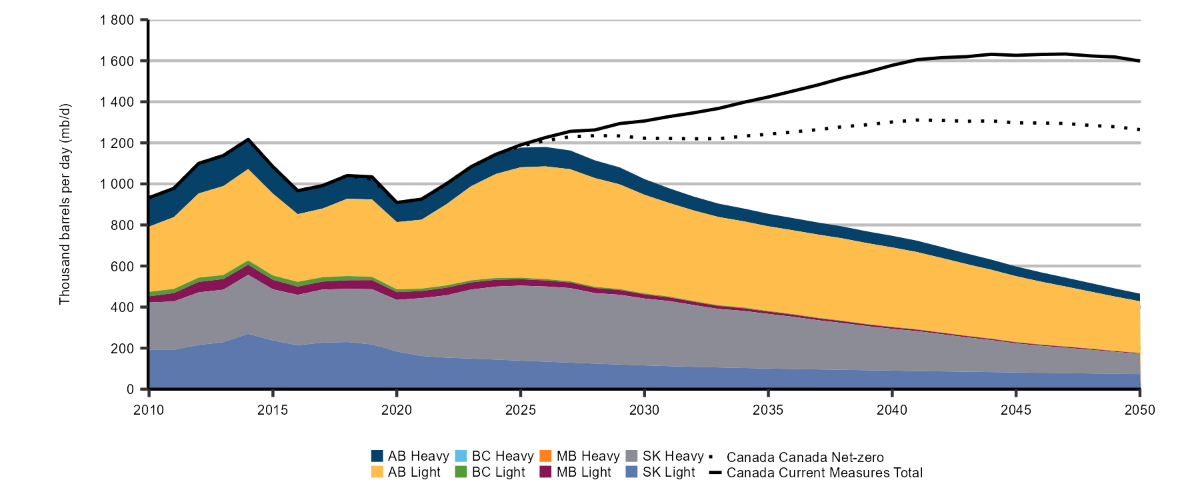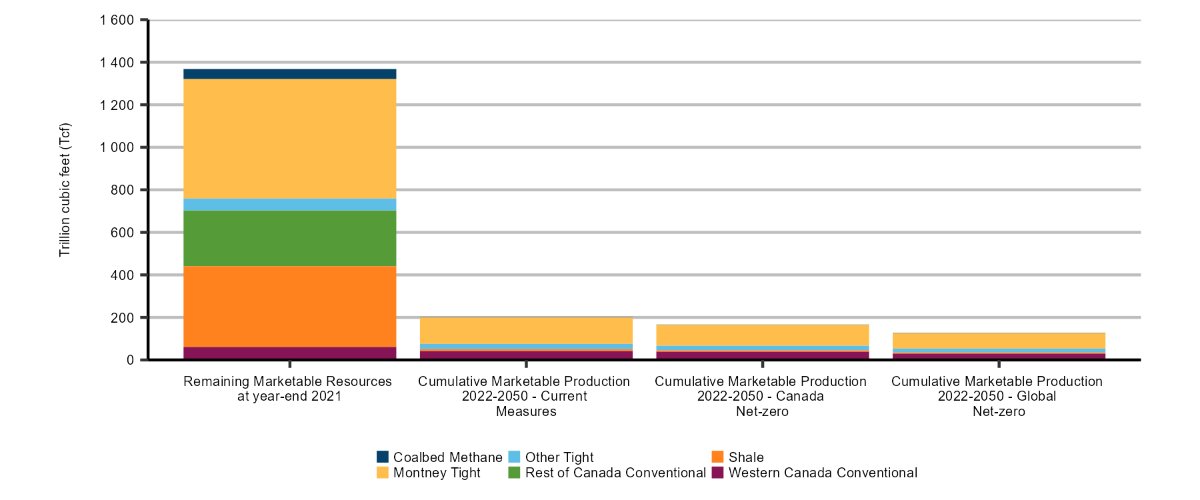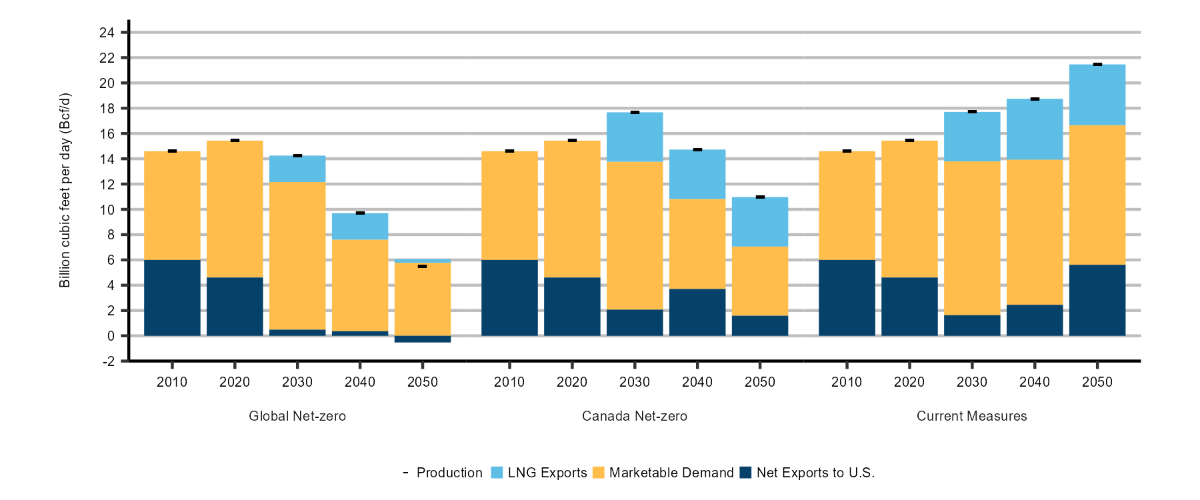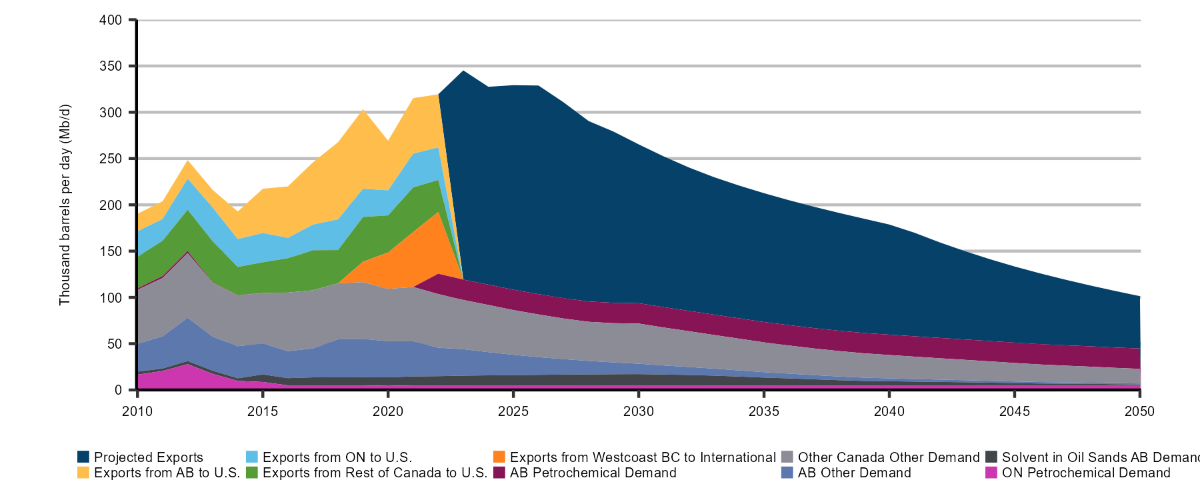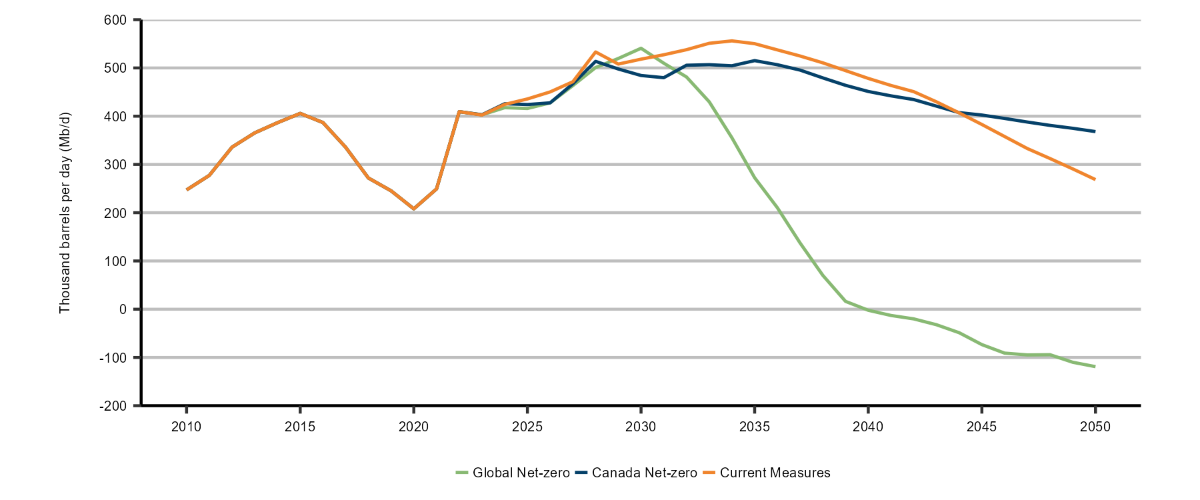
Canada’s Energy Future 2023: Energy Supply and Demand Projections to 2050 – Data Supplement
Canada’s Energy Future series explores how possible energy futures might unfold for Canadians over the long term. Canada’s Energy Future 2023 focuses on the challenge of achieving net-zero greenhouse gas emissions by 2050. For the first time, we explore net-zero scenarios to help Canadians and policy makers see what a net-zero world could look like. Our scenarios cover all energy commodities and all Canadian provinces and territories. We use economic and energy models to do this analysis. This data supplement shares additional information on specific topics not included in the original report.
Index
Demand
- Figure 1: End-use energy intensity trends by end-use subsector, Global Net-zero scenario
- Figure 2: Kaya identity, or trends in key drivers of GHG emission levels, Global Net-zero scenario
- Figure 3: 2050 GHG emissions, Global Net-zero scenario
- Figure 4: Bioenergy demand by type and sector, Global Net-zero scenario
Electricity
Oil and Natural Gas Production
- Figure 12: Emissions intensity of oil sands production, all scenarios
- Figure 13: Oil sands production equipped with CCUS, Global Net-zero and Canada Net-zero scenarios
- Figure 14: Indexed mined, plus in situ oil production, and light and heavy oil production, all scenarios
- Figure 15: Western Canada conventional oil production, 2000-2050, Global Net-zero scenario
- Figure 16: CO2 emitted versus captured from oil and gas facilities, all scenarios
- Figure 17: Natural gas production by resource, 2000-2050, all scenarios
- Figure 18: Natural gas production by well vintage, 2015-2050, all scenarios
- Figure 19: Remaining marketable natural gas resources at year-end 2021 in Canada, by type, all scenarios
- Figure 20: Canada natural gas disposition, 2010-2050, all scenarios
- Figure 21: Canadian ethane potential and production, 2010-2050, all scenarios
- Figure 22: Canada propane disposition, 2010-2050, Global Net-zero scenario
- Figure 23: Net imports of pentanes plus and condensate, 2010-2025, all scenarios
Demand
Figure 1: End-use energy intensity trends by end-use subsector, Global Net-zero scenario
Description
Description: This line chart shows energy intensity trends by end-use subsector in the Global Net-zero scenario from 2021 to 2050 (indexed to 100). Energy intensity for passenger transport declines the most, to 30 by 2050 (or a 70% decline relative to 2021 levels), while the decline in energy intensity for freight transport is much lower, at 66 by 2050. Residential and commercial buildings’ energy intensities decline to 60 and 53, respectively. Industrial energy intensities decline the least, to 72, 76, and 89 for other industries, heavy industry, and oil and gas, respectively.
Figure 2: Kaya identity, or trends in key drivers of GHG emission levels, Global Net-zero scenario
Description
Description: This line chart shows trends in the main drivers of greenhouse gas (GHG emissions), or Kaya identityDefinition* in the Global Net-zero scenario. These include population growth, standards of living (gross domestic product per capita (GDP/capita)), energy intensity (energy use per level of GDP), and carbon intensity (how emissions-intensive that energy is). Trends to 2050 are shown as an index relative to 2021 levels, where 2021 = 100. For example, by 2050, with a value of 129, population levels in Canada will be 29% larger than in 2021. Other indexed values for 2050 are: 114 for GDP per capita (a 14% increase), 66 for energy intensity (or a 44% decline relative to 2021 levels), 7 for carbon intensity, and 0 for net GHG emissions.
Figure 3: 2050 GHG emissions, Global Net-zero scenario
Description
Description: Net zero GHG emissions by 2050 means that any remaining emissions across the economy are offset by an equal number of removals. This tree map chart shows GHG emissions that remain (top panel) and the corresponding offsets, or negative emissions (bottom panel), by sector, in 2050, for the Global Net-zero scenario, as a share of a total of +/-153 megatonnes of carbon dioxide equivalent (CO2e). Emissions remain across sectors where stock turnover is slow or where decarbonization options are limited – like in buildings (16%), transportation (10%), and heavy industry (13%). Across other sectors, remaining emissions are mostly a function of activity levels – including agriculture (33%), waste and others (17%), and oil and gas production (11%). The use of biomass with Carbon Capture and Storage (CCS) for electricity, and hydrogen production is a key emission offsetting solution. So are the use of direct air capture (DAC) (30%) and nature-based solutions (captured in the Land Use, Land Use Change and Forestry (LULUCF) category (33%)).
Figure 4: Bioenergy demand by type and end-use sector, Global Net-zero scenario
Description
Description: This stacked bar chart shows bioenergy demand in Canada’s four end-use sectors for the Global Net-zero scenario. Different types and mixes of bioenergy are used for each sector depending on their end uses. Total bioenergy demand increases by nearly 30% from 761 PJ in 2021 to 1,065 PJ in 2050. The commercial and residential sectors use the least bioenergy, much of it as renewable natural gas blended into current natural gas infrastructure. The residential sector sees a decline in biomass used for wood stoves as the sector electrifies. The transportation sector uses biofuels and accounts for nearly 300 PJ, or 25% of the total bioenergy demand in 2050. The industrial sector uses the most bioenergy and makes up 65% of the total demand by 2050. This industrial demand is met by a mix of bioenergy types due to the diverse nature of Canada’s industries and production processes.
Figure 5: Total carbon captured and removed, excluding nature-based solutions, all scenarios
Description
Description: This stacked bar chart shows total carbon captured, utilized, and stored (CCUS) by sector and scenario, excluding nature-based solutions. In all scenarios, CCUS increases out to 2050, with the sectoral contributions changing over time and by scenario. Current Measures has the least CCUS over time with 33 MT in 2050. Most of the CCUS is from the oil and gas sector. The Net-zero scenarios see CCUS of 220 MT by 2050 in the Canada Net-zero scenario and 180 MT in the Global Net-zero scenario. Although oil and gas CCUS makes up a significant portion in 2030 in both scenarios, it makes up a greater portion in the Canada Net-zero scenario in 2040 and 2050 than in the Global Net-zero scenario. This is due to greater declines in production of oil and gas in the Global Net-zero scenario. In both the Canada Net-zero and Global Net-zero scenarios, direct air capture (DAC), electricity generation, and hydrogen production contribute to greater than 70% of the total CCUS by 2050. In the Global Net-zero scenario, these sectors account for 7 MT fewer CCUS than the Canada Net-zero scenario due to the need for fewer emissions offsets in this scenario.
Figure 6: Aggregate cost of carbon, all scenarios
Description
Description: This stacked bar chart shows two carbon pricing components, by scenario, for 2030 and 2050, in $2022 CDN (or inflation-adjusted) terms per tonne of carbon dioxide equivalent ($2022 CDN/t of CO2e). The federal backstop carbon pricing component is the same across all scenarios – increasing from $50 in 2022 to $140 in 2030 ($170 nominal). After 2030, this carbon pricing component is assumed to be fixed in nominal terms, which is why the inflation-adjusted price declines to $95 by 2050. The second component is the aggregate cost of carbon – which represents a hypothetical suite of policies, regulations, and programs needed to reach net-zero GHG emissions in Canada by 2050. This component increases from $0 in 2030, to $330 by 2050 in the Global Net-zero scenario, and $380 by 2050 in the Canada Net-zero scenario.
Figure 7: Energy use, passenger vs freight transport, Global Net-zero scenario
Description
Description: This stacked area chart shows energy demand in passenger and freight transportation, including aviation fuels, in the Global Net-zero scenario. Although the decline in fossil fuel demand is greater than 80% in both transportation subsectors out to 2050, the mix of low carbon fuels that replace it varies. In passenger transportation, 50% of the energy demand is electrified. As electric vehicles are 3 to 5 times more efficient than conventional gasoline and diesel vehicles, total energy demand declines by 30% in this sub-sector as well. In freight transportation, over 50% of the energy demand by 2050 is hydrogen. As freight transportation vehicles are significantly larger and heavier than passenger vehicles, hydrogen becomes a cost-competitive alternative to electricity.
Electricity
Figure 8: Electricity peak demand by province, 2050 compared to 2021, all scenarios
Description
Description: This bar chart illustrates the relative magnitude of peak electricity demand in different scenarios for the year 2050 compared to the observed peak demand in 2021 for each province and territory. Peak electricity demand is influenced by economic and population growth. However, in the Net-zero scenarios, due to increased electrification, peak demand experiences significantly higher growth across most regions. For instance, in the Global Net-zero scenario, peak electricity demand in 2050 can be 1.3 to 3.6 times that of 2021, depending on the region. Ontario exhibits the highest growth in peak demand in all scenarios, owing to its larger population and economy. Net-zero scenarios generally see higher peak demand growth in all regions except for Quebec. In the net-zero scenarios, peak demand growth in Quebec is lower compared to the Current Measures scenario due to improved energy consumption efficiency in residential and commercial buildings. This efficiency enhancement is primarily achieved through the increased adoption of heat pumps for space heating. In contrast, the Current Measures scenario relies on less efficient baseboard heaters as the main technology for space heating.
Figure 9: Electricity generation and storage capacity by fuel and technology, in 2021 and 2050, all scenarios
Description
Description: The stacked column chart presents electricity capacity categorized by fuel and technology for the years 2021 and 2050 across all scenarios. In 2021, Canada's total electricity generation capacity was 152 GW. In 2050, the Net-zero scenarios project substantial growth, with total generation capacity more than doubling. The Global Net-zero scenario projects total generation capacity reaching 328 GW, while the Canada Net-zero scenario projects 351 GW of generation capacity. In contrast, the Current Measures scenario shows significant but comparatively lower growth, with generation capacity projected to reach 268 GW by 2050. Onshore wind sees the most significant growth in all scenarios, from 14 GW in 2021 to 91 GW in 2050 Global Net-zero, 106 GW in Canada Net-zero, and 70 GW in Current Measures. Small modular reactors (Uranium SMR), an emerging technology that did not exist in 2021, sees significant growth in Net-zero scenarios, with installed capacity reaching nearly 25 GW. Growth in fossil fuel-based electricity generation in the Net-zero scenarios is from natural gas with CCUS. In 2050, natural Gas CCUS capacity in the Global Net-zero scenario is 27 GW, and in the Canada Net-zero scenario it is 18 GW, and there is none in the Current Measures scenario, but there is a significant rise in conventional natural gas electricity generation, nearly doubling from 23 GW in 2021 to 44 GW by 2050. Battery storage grows to 6 GW in Canada Net-zero and 9 GW in Global Net-zero scenarios.
Figure 10: Electricity generation by fuel and technology, in 2021 and 2050, all scenarios
Description
Description: This stacked column chart shows electricity generation by fuel in 2021 and in 2050 in all three scenarios. The fuel types are biomass / geothermal, hydro, oil, uranium, coal and coke, natural gas, solar, and wind. In 2021, total electricity generation was 625 TWh, by 2050, total generation increases to 973 TWh in the Current Measures scenario, 1,360 TWh in the Canada Net-zero scenario, and 1,292 TWh in the Global Net-zero scenario. In all three cases, hydropower remains a dominant source of electricity supply, accounting for 378 TWh in 2021, rising to 440 TWh in the Current Measures scenario, 474 TWh in Canada Net-zero scenario and 476 TWh in the Global Net-zero scenario. Wind power sees the most significant growth in all scenarios. In 2021 wind generation contributed only 35 TWh to total generation. By 2050 wind rises to 248 TWh in the Current Measures scenario, 425 TWh in the Canada Net-zero scenario, and 370 TWh in the Global Net-zero scenario. Electricity produced by small modular reactors is a significant contributor to electricity generation in the Net-zero scenarios. By 2050 electricity supplied by them reaches 160 TWh in the Canada Net-zero scenario and 155 TWh in Global Net-zero scenario. In each of the three scenarios, both distributed and utility solar generation increases over tenfold. By 2050, electricity supply from these sources reaches 63 TWh in the Current Measures scenario, 75 TWh in the Canada Net-zero scenario, and 62 TWh in the Global Net-zero scenario.
Figure 11: Renewables and electricity share, 2021 and 2050, Global Net-zero
Description
Description: This chart compares electricity demand and electricity generated from renewable sources in the Global Net-zero Scenario for all regions in 2021 and 2050. The vertical axis represents the percentage of electricity demand in end-use demand, while the horizontal axis represents the percentage of renewable energy used for electricity generation. In 2021, all regions except Quebec saw less than 30% of end-use demand met with electricity. However, there is a shift by 2050. New Brunswick, Ontario, Manitoba, Northwest Territories, Newfoundland and Labrador, Prince Edward Island, and Quebec have over 40% of their end-use demand met with electricity. In 2021, only Quebec, Prince Edward Island, Manitoba, Newfoundland and Labrador, Yukon, and British Columbia used renewables for electricity generation. In 2050 there is a significant shift. All regions except Nunavut and Prince Edward Island generate over 50% of their electricity from renewable sources. This chart highlights the shift in both electricity use and renewable generation. By 2050, the proportion of electricity generated will increase to meet the growing demand for end-use demand. The proportion of electricity generated from renewable sources will also rise to meet this rising demand.
Oil and Natural Gas Production
Figure 12: Emissions intensity of oil sands production, all scenarios
Description
Description: This line chart shows the emissions intensity of oil sands production in all three scenarios. In all three scenarios the emissions intensity of bitumen production declines from a high of 0.059 tonnes per barrel in 2018. In the Global Net-zero scenario, emissions intensity quickly declines beginning in the mid-2020s falling to 0.015 by 2038, then declines more slowly to 0.009 in 2050. In the Global Net-zero scenario, emissions intensity quickly declines beginning in the mid-2020s to 0.008 by 2038 and then declines only slightly to 0.007 in 2050. In the Current Measures scenario, emissions intensity steadily declines throughout the projection period until it reaches 0.041 by 2050. In the Global Net-zero and Canada Net-zero scenarios, emission declines are largely driven by CCUS adoption at oil sands facilities. In the Current Measures scenario most of the reduction is driven by efficiency improvements.
Figure 13: Oil sands production equipped with CCUS, Global Net-zero and Canada Net-zero scenarios
Description
Description: These two area charts show how much bitumen production comes from oil sands projects using Carbon Capture Utilization and Storage (CCUS) and projects that are not using CCUS. In the Global Net-zero scenario, production with CCUS begins in 2026, peaks in 2037 at 1.43 million barrels per day (MMb/d), then falls to 0.43 MMb/d by 2050. Production without CCUS peaks in 2024 at 3.40 MMb/d, then falls to 0.04 MMb/d by 2050. In the Canada Net-zero scenario production with CCUS begins in 2026, peaks in 2038 at 2.96 MMb/d, then falls to 2.15 MMb/d by 2050. Production without CCUS peaks in 2024 at 3.42 MMb/d, then falls to 0.16 MMb/d by 2050.
Figure 14: Indexed mined, plus in situ oil production, and light and heavy oil production, all scenarios
Description
Description: These two line charts show indexed production of mined and in situ oil sands production and indexed production of conventional light and heavy oil production. Under the Global Net-zero scenario, production increases to 1.08 of 2021 values in 2027 (in the Canada Net-zero scenario, 1.12 in 2027, and in the Current measures scenario, 1.19 in 2029) for mined and in situ production it then falls to 0.14 in 2050 (in the Canada Net-zero scenario, 0.71, and in the Current measures scenario, 1.11). Light and heavy oil production increases to 1.20 of 2021 values in 2026 (in the Canada Net-zero scenario, 1.32 in 2029, and in the Current measures scenario, 1.49 in 2038) and then falls to 0.39 in 2050 (in the Canada Net-zero scenario, 1.08, and the Current measures scenario, 1.39).
Figure 15: Western Canada conventional oil production, 2000-2050, Global Net-zero scenario
Description
Description: This chart shows the production of conventional, tight and shale oil production by province, and by class, for the Global Net-zero scenario. British Columbia light oil production declines from 42 Mb/d in 2010 to 1 Mb/d in 2050. Heavy oil production in B.C. is nil. Alberta light oil production decreases from 318 Mb/d in 2010 to 251 Mb/d in 2050 and heavy from 141 Mb/d to 37 Mb/d. Saskatchewan light oil production grows from 192 Mb/d in 2010 to 270 Mb/d in 2014 then down to 73 Mb/d in 2050. Saskatchewan heavy oil production is 231 Mb/d in 2010 and 99 Mb/d in 2050. Manitoba only has light oil production, which grows from 30 Mb/d in 2010 to 52 Mb/d in 2013 then down to 3 Mb/d in 2050. In the Global Net-zero scenario total production goes from 933 Mb/d in 2010 to 465 Mb/d in 2050. In the Current Measures scenario total production is 1 599 Mb/d in 2050, and 1 264 Mb/d in the Canada Net-zero scenario.
Figure 16: CO2 emitted versus captured from oil and gas facilities, all scenarios
Description
Description: These three stacked area charts show how much Carbon Capture Utilization and Storage (CCUS) is being used at oil and gas facilities, versus how many emissions remain unabated, in all scenarios. In all scenarios emissions peak in 2018 at 179 MT of CO2e per year. In the Global Net-zero scenario, oil and gas facilities abate a maximum of 38 MT of CO2 in 2034 (57 MT in the Canada Net-zero scenario in 2036, and 15 MT in the Current Measures scenario in 2034). The total amount of emissions falls to 20 MT in 2050 in Global Net-zero (27 MT in the Canada Net-zero scenario, and 134 MT in the Current Measures scenario).
Figure 17: Natural gas production by resource, 2000-2050, all scenarios
Description
Description: These three stacked areas charts show natural gas production in Canada from 2010 to 2050, from various extraction methods and resources for each scenario. This chart also shows natural gas prices for all scenarios. Western Canada solution gas shrinks from 1.4 billion cubic feet per day (Bcf/d) in 2010 to 1.1 Bcf/d in 2050 in the Global Net-zero scenario (2.7 in the Canada Net-zero scenario, 3.1 in the Current Measures scenario). Western Canada coal bed methane declines from 1.0 Bcf/d in 2010 to 0.03 Bcf/d in 2050 in all scenarios. Western Canada conventional declines over the projection from 6.7 Bcf/d in 2010 to 0.2 Bcf/d in 2050 in the Global Net-zero scenario (0.3 in the Canada Net-zero scenario, and 0.5 in the Current Measures scenario). Conventional natural gas production from the rest of Canada declines from 0.3 Bcf/d in 2010 to 0 Bcf/d by 2032 in all scenarios. Alberta Montney production is 0.2 Bcf/d in 2010 and grows to 0.9 Bcf/d by 2050 in the Global Net-zero scenario (1.5 Bcf/d in the Canada Net-zero scenario, 3.5 Bcf/d in the Current Measures scenario) while BC Montney production is 0.6 Bcf/d in 2010 and reaches 2.6 Bcf/d by 2050 in the Current Measures scenario (5.4 Bcf/d in the Canada Net-zero scenario, 11.3 Bcf/d in the Current Measures scenario). Alberta Deep Basin production is 2.7 Bcf/d in 2010 and declines to 0.5 Bcf/d by 2050 in the Global Net-zero scenario (0.7 Bcf/d in the Canada Net-zero scenario, 1.9 Bcf/d in the Current Measures scenario) while tight gas from other western Canada plays declines from 1.6 Bcf/d in 2010 to 0.1 Bcf/d by 2050 in all scenarios. The Duvernay Shale begins production in 2012 and grows to 0.2 Bcf/d by 2050 in the Global Net-zero scenario (0.3 Bcf/d in the Canada Net-zero scenario, 0.9 Bcf/d in the Current Measures scenario) while the Horn River Basin shales produce 0.2 Bcf/d in 2010 and less than 0.1 Bcf/d in 2050 in all scenarios. Other western Canada shale plays account for less than 0.05 Bcf/d throughout the projection. Total production is 17.3 Bcf/d in 2022 and decreases to 5.5 Bcf/d in 2050 in the Global Net-zero scenario (11.0 Bcf/d in the Canada Net-Zero scenario, 21.5 Bcf/d in the Global Net-zero scenario). The Alberta natural gas price is $3.16 (2022 C$/million British thermal units (MMBTU)) in 2010, $5.43 in 2022, and in 2050 the price is $2.20 in the Global Net-zero scenario ($2.96 in the Canada Net-zero scenario, $4.56 in the Current Measures scenario).
Figure 18: Natural gas production by well vintage, 2015-2050, all scenarios
Description
Description: These three stacked area charts show the amount of natural gas that comes from wells of differing types and ages for all scenarios. Solution gas, gas that comes from oil wells, was 2.4 Bcf/d in 2015 and is 1.1 Bcf/d in 2050 in the Global Net-zero scenario (2.7 Bcf/d in the Canada Net-zero scenario, 3.1 Bcf/d in the Current Measures scenario). Gas that comes from wells that have already been drilled totals 12.8 Bcf/d in 2015 and falls to 0.7 Bcf/d by 2050. New wells are projected to produce 5.1 Bcf/d in 2023 and decrease to 3.1 Bcf/d by 2050 in the Global Net-zero scenario (4.9 Bcf/d in the Canada Net-zero scenario, 14.0 Bcf/d in the Current Measures scenario). Future wells drilled will directly supply most liquefied natural gas (LNG) exports start coming online in 2025 and produce 0.6 Bcf/d by 2050 in the Global Net-zero scenario (2.7 Bcf/d in the Canada Net-zero scenario, and 3.6 Bcf/d in the Current Measures scenario).
Figure 19: Remaining marketable natural gas resources at year-end 2021 in Canada, by type, all scenarios
Description
Description: This chart shows the natural gas resources in Canada at year-end 2021 along with the cumulative production from 2022 to 2050 for each scenario. Coal bed methane resources total 47 trillion cubic feet (Tcf). Western Canada conventional account for 61 Tcf. Rest of Canada conventional has 263 Tcf. Montney Tight gas has 561 Tcf of gas resources. Other tight resources account for 56 Tcf. Shale resources amount to 380 Tcf. Cumulative production amounts to only 9% of the resources available by the end of the projection period in 2050 in the Global Net-zero scenario (12% in the Canada Net-zero scenario, and 15% in the Current Measures scenario).
Figure 20: Canada natural gas disposition, 2010-2050, all scenarios
Description
Description: This chart shows marketable demand, marketable production, net exports to the United States (U.S.), and LNG exports, from 2010 to 2050, in 10-year increments, for each scenario. In 2010 demand is 8.6 Bcf/d and shrinks to 5.8 Bcf/d in the Global Net-zero scenario (5.5 Bcf/d in the Canada Net-zero scenario, 11.0 Bcf/d in the Current Measures scenario). In 2010, production is 14.6 Bcf/d and grows to 5.5 Bcf/d in the Global Net-zero scenario (11.0 Bcf/d in the Canada Net-zero scenario, 21.5 Bcf/d in the Current Measures scenario). In 2010, net exports are 6.0 Bcf/d and decline to -0.5 Bcf/d in the Global Net-zero scenario (3.7 Bcf/d in the Canada Net-zero scenario, 5.6 Bcf/d in the Current Measures scenario). In 2010, LNG exports are zero and become 0.3 Bcf/d in 2050 in the Global Net-zero scenario (3.9 Bcf/d in the Canada Net-zero scenario, 4.8 Bcf/d in the Current Measures scenario).
Figure 21: Canadian ethane potential and production, 2010-2050, all scenarios
Description
Description: These three stacked area charts show the potential production of ethane along with the projected actual production from gas processing and off gas plants for all three scenarios. Production of ethane from both sources decreases over the projection from 236 Mb/d in 2010 to 139 Mb/d in 2050 in the Global Net-zero scenario (264 Mb/d in the Canada Net-zero scenario, 351 Mb/d in the Current Measures scenario). Ethane imports go from 38 Mb/d in 2014 to 324 Mb/d in 2050 in the Global Net-zero scenario (207 Mb/d in the Canada Net-zero scenario, and 124 Mb/d in the Current Measures). Ethane not recovered goes from 39 Mb/d in 2014 to zero by 2032 and beyond in the Global Net-zero scenario (zero by 2044 and beyond in the Canada Net-zero scenario, 260 Mb/d in 2050 in the Current Measures scenario). Demand for ethane in Canada grows from 210 Mb/d in 2010 to 463 Mb/d in 2050 in the Global Net-zero scenario (471 Mb/d in the Canada Net-zero scenario, and 475 Mb/d in the Current Measures scenario).
Figure 22: Canada propane disposition, 2010-2050, Global Net-zero scenario
Description
Description: This chart shows the disposition of propane in Canada from 2010 to 2050 for the Global Net-zero scenario. Alberta petrochemical demand grows over the projection from 2 Mb/d in 2010 to 22 Mb/d in 2050. Ontario petrochemical demand falls from 17 Mb/d in 2010 to 5 Mb/d in 2050. Demand for propane as a solvent in the oil sands declines from 3 Mb/d in 2010 to 1 Mb/d in 2050. Other Alberta demand for propane declines from 30 Mb/d in 2010 to 1 Mb/d in 2050. Similarly, other Canadian demand falls from 58 Mb/d in 2010 to 16 Mb/d in 2050. Exports from all of Canada rise from 81 Mb/d in 2010 to 226 Mb/d in 2023, then fall to 57 Mb/d in 2050. Total disposition declines from 190 Mb/d in 2010 to 101 Mb/d in 2050.
Figure 23: Net imports of pentanes plus and condensate, 2010-2025, all scenarios
Description
Description: This chart shows net imports of pentanes plus and condensate aggregated from 2010 to 2050 for all three scenarios. In the Global Net-zero scenario net imports are 247 Mb/d in 2010, grow to 541 Mb/d by 2030, then decline to below zero by 2040. Canada remains a net exporter reaching net exports of 119 Mb/d by 2050. In the Canada Net-zero scenario, net imports reach 515 Mb/d in 2035 and are 368 Mb/d in 2050. In the Current Measures scenario net imports grow to 556 Mb/d by 2034 and decline to 269 Mb/d by 2050.
Missing something? If you are looking for the production/supply supplemental data or the factsheets that we used to publish, that data is still available to download here:
- Date modified:

